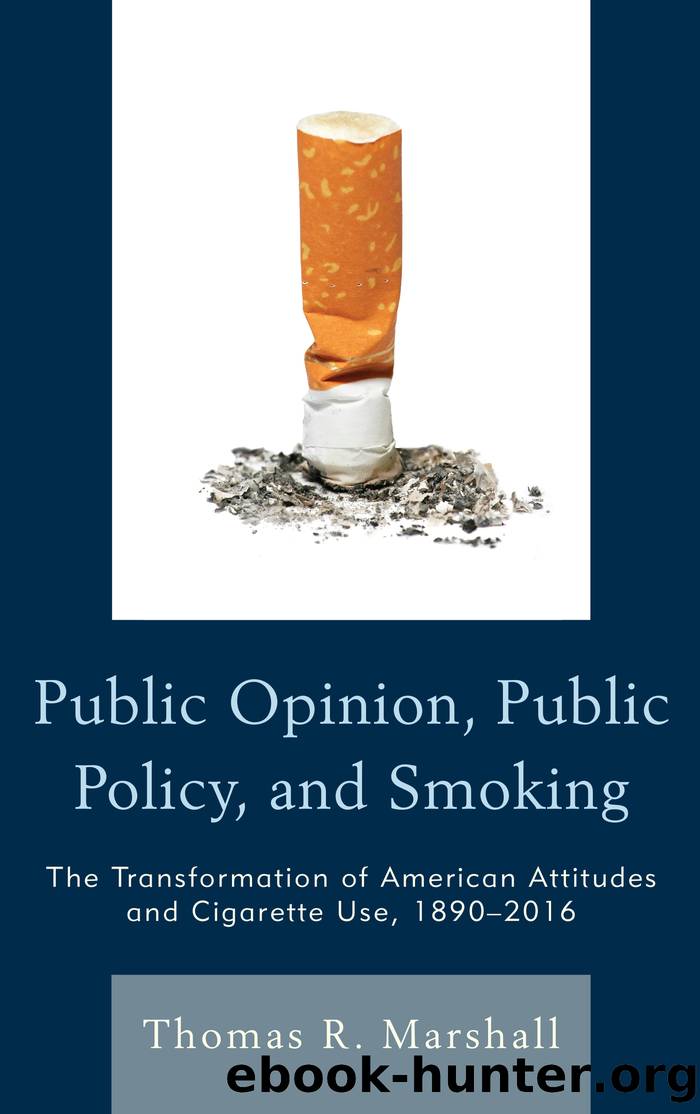Public Opinion, Public Policy, and Smoking by Marshall Thomas R.;

Author:Marshall, Thomas R.;
Language: eng
Format: epub
Tags: undefined
Publisher: Lexington Books/Fortress Academic
Published: 2012-08-15T00:00:00+00:00
Studying Public Opinion and
Federal Decisions on Smoking
As this discussion suggests, tobacco control advocates sometimes successfully changed federal policy toward smoking but at other times the tobacco industry has prevailed, at least for a time, and a pro-tobacco status quo continued. Some policy decisions are made by the elective branches, Congress and the White House, and others by the federal agencies or by the federal courts. Some, but not all these policy decisions receive widespread attention from the media, from the American public, and from pollsters. Some decisions are far-reaching, others narrowly-focused. The tobacco industry, its lobbyists, and its lawyers fought long, hard, and expensively against some of these policy decisions, but were divided on or even acquiesced to others.
This chapter now asks two simple but important questions. First, how often do tobacco-related policies agreed with American public opinion? Second, does American public opinion influence tobacco policy-making?
American pollsters often ask poll questions on tobacco-related issues, especially when an issue is currently being debated or soon after a policy decision occurs. On low-profile controversies pollsters may ask only a single poll question, if any at all, but on high-profile controversies such as the Master Settlement Agreement, pollsters ask dozens of questions. Comparing carefully-measured poll questions with a final policy decision makes it possible to judge whether or not a decision is consistent with public opinion. Herein fifty-nine federal-level tobacco control policy decisions are compared (or âmatchedâ) with timely nationwide polls; each poll to policy match is classified as either âconsistentâ or as âinconsistentâ with public or in a few cases as âunclear.â[18] A consistent policy decision is one that agrees, in substance, with a timely nationwide poll majority (or occasionally with a plurality). An inconsistent policy decision is one that disagrees with a current poll majority or plurality. In a few cases of evenly-divided or inconsistent poll results, the poll to policy match is classified as unclear.
As an example of a consistent decision, consider the 1965 requirement that a warning label (at that time: âCaution: Cigarette Smoking May Be Hazardous to Your Healthâ) appear on cigarette packages. Several poll questions showed that most Americans favored a package warning. In an industry-sponsored poll conducted a day before the 1964 Surgeon General advisory committeeâs report was released, a 65 percent to 22 percent majority favored a warning. That figure jumped to 72 percent to 21 percent in favor a few days later and was 64 percent to 25 percent in favor six weeks later (Marshall 2015). Other polls show the same result. In the federal governmentâs fall 1964 Use of Tobacco survey 60 percent of Americans favored a package warning, and in spring 1966 75 percent of Americans did. In a December 1966 Harris poll a 76 percent to 10 percent majority favored the warning; a 57 percent to 32 percent majority said that it was not necessary to place the warning where it could be more easily seen. Accordingly, the 1965 package warning requirement is classified as âconsistentâ with public opinion.
Some tobacco control policies are inconsistent with American public opinion.
Download
This site does not store any files on its server. We only index and link to content provided by other sites. Please contact the content providers to delete copyright contents if any and email us, we'll remove relevant links or contents immediately.
| Antitrust | Civil Law |
| Emigration & Immigration | Federal Jurisdiction |
| Housing & Urban Development | Indigenous Peoples |
| Land Use | Public |
| Public Contract | Public Utilities |
| Urban, State & Local Government |
Machine Learning at Scale with H2O by Gregory Keys | David Whiting(3981)
Killers of the Flower Moon by David Grann(3907)
Oathbringer (The Stormlight Archive, Book 3) by Brandon Sanderson(2801)
Will by Will Smith(2744)
Once Upon a Broken Heart by Stephanie Garber(2626)
Guns, Germs and Steel by Diamond Jared(2242)
It Starts With Us (It Ends with Us #2) by Colleen Hoover(2158)
Borders by unknow(2152)
Friends, Lovers, and the Big Terrible Thing by Matthew Perry(2085)
The Room Where It Happened by John Bolton;(2074)
The Color of Law by Richard Rothstein(1842)
HBR's 10 Must Reads 2022 by Harvard Business Review(1742)
A Short History of War by Jeremy Black(1732)
The Strength In Our Scars by Bianca Sparacino(1724)
Water Rights and the Environment in the United States by John Burch(1625)
Examples & Explanations: Administrative Law by William F. Funk & Richard H. Seamon(1578)
515945210 by Unknown(1569)
A Game of Thrones (The Illustrated Edition) by George R. R. Martin(1516)
Pharmacy Practice and The Law by Richard Abood(1513)
